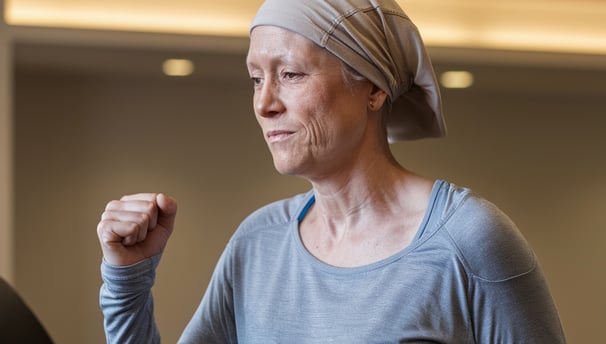

Benefits During Treatment
Improvement of Mental Well-being: Physical activity can help reduce anxiety and depression, common symptoms in cancer patients. A study found that moderate exercise can significantly improve mood and quality of life (Pinto et al., 2021).
eduction of Side Effects: Exercise can help mitigate some of the side effects of treatment, such as fatigue, muscle loss, and changes in cardiovascular function (Schmitz et al., 2019).
Improvement of Strength and Endurance: Regular physical activity can increase muscle strength and endurance, which can facilitate daily activities and improve overall quality of life (Segal et al., 2017).
Better Pain Management: Physical activity can help reduce pain and improve mobility, which is especially beneficial for those suffering from chronic pain related to cancer (Cramer et al., 2016).
Immune Support: Staying active can help strengthen the immune system, which is crucial for fighting cancer and preventing infections during treatment (Mikulski et al., 2018).
Post-Cancer Benefits
Reduction of Recurrence Risk: Several studies suggest that regular physical activity may reduce the risk of recurrence (Kwan et al., 2017).
Weight Management: Exercise helps maintain a healthy weight, which is important since being overweight can increase the risk of certain types of cancer (Schmid & Leitzmann, 2014).
Improvement of Cardiovascular Health: Physical activity can improve heart health, which is especially important for those who may have a higher risk of cardiovascular disease due to treatments like chemotherapy (Rock et al., 2021).
Quality of Life: Physical activity is associated with improved quality of life and emotional well-being, helping with social and emotional reintegration (Hernandez et al., 2020).
Benefits of Strength Training
Preservation of Muscle Mass: Maintaining muscle mass is crucial during treatment. Strength training helps prevent muscle loss, which can be a side effect of treatment (Schmitz et al., 2019).
Improvement of Functionality: Strengthening muscles can facilitate daily activities and improve quality of life (Segal et al., 2017).
Psychological Benefits: Strength training can also help improve mood and self-confidence, which is essential for emotional recovery (Fong et al., 2019).
Injury Prevention: A well-designed strength training program can help prevent injuries by improving stability and coordination.
How to Perform Strength Training
Medical Consultation: It is essential to consult with a doctor or physiotherapist before starting any exercise program, especially if undergoing treatment.
Start Gradually: Begin with low-impact exercises and increase intensity as strength improves.
Recommended Exercises:
Full-body Exercises: Incorporate movements that strengthen multiple muscle groups, such as squats, push-ups, and light weight lifting.
Use of Resistance Bands: These are an excellent option for strength training without the risk of injury.
Light Dumbbells: These help target specific muscles, such as biceps and triceps.
Repetitions and Sets: It is recommended to start with 1-2 sets of 8-12 repetitions, gradually increasing as strength and endurance improve.
Frequency: It is suggested to train 2-3 times per week, allowing one day of rest between sessions.
Listen to Your Body: Pay attention to any signs of discomfort. It is important to adapt exercises based on capabilities and physical condition.
Conclusions
Physical activity and exercise offer significant benefits for individuals dealing with this illness. Staying active not only improves physical health but also contributes to better mental and emotional well-being. Incorporating strength training can be especially beneficial in the recovery process.
References
Cramer, H., et al. (2016). Effects of exercise on cancer-related fatigue in cancer survivors: a systematic review and meta-analysis. Journal of Cancer Survivorship, 10(3), 507-518.
Fong, D. Y. T., et al. (2019). Physical activity for cancer survivors: a systematic review. Cancer Treatment Reviews, 73, 88-99.
Hernandez, T. L., et al. (2020). The impact of exercise on quality of life in cancer survivors: a systematic review. Supportive Care in Cancer, 28(3), 1115-1124.
Kwan, M. L., et al. (2017). Physical activity and survival after breast cancer diagnosis: results from the LACE study. Cancer Epidemiology, Biomarkers & Prevention, 26(7), 1068-1075.
Mikulski, M., et al. (2018). The role of exercise in cancer prevention and treatment. Supportive Care in Cancer, 26(3), 899-906.
Pinto, B. M., et al. (2021). Effects of exercise on psychosocial outcomes for cancer patients: a systematic review. Cancer, 127(2), 238-246.
Rock, C. L., et al. (2021). Nutrition and physical activity guidelines for cancer survivors. CA: A Cancer Journal for Clinicians, 71(3), 175-203.
Schmid, D., & Leitzmann, M. F. (2014). Physical activity and cancer prevention: a systematic review of the epidemiologic evidence. Cancer Causes & Control, 25(1), 29-46.
Schmitz, K. H., et al. (2019). American College of Sports Medicine roundtable on exercise guidelines for cancer survivors. Medicine & Science in Sports & Exercise, 51(11), 2373-2380.
Segal, R. J., et al. (2017). Exercise for people with cancer: a systematic review. Current Oncology, 24(6), e545-e558.

